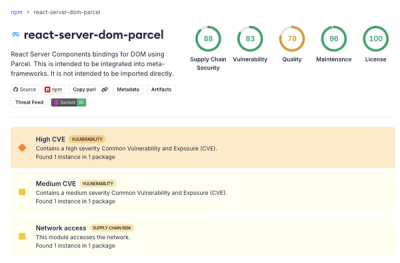
Security News
Deno 2.6 + Socket: Supply Chain Defense In Your CLI
Deno 2.6 introduces deno audit with a new --socket flag that plugs directly into Socket to bring supply chain security checks into the Deno CLI.
@commercetools-test-data/core
Advanced tools
This package provides the core functions to define the data models
@commercetools-test-data/coreThis package provides the core functions to define the data models.
$ pnpm add -D @commercetools-test-data/core
Models are defined in the models/* workspace and are grouped by domain in different packages.
To create a new model, add a new package in the models workspace with the following structure:
models/<package_name>
├── LICENSE
├── README.md
├── index.ts
├── package.json
├── src
│ └── <model_name>
│ ├── builder.ts
│ ├── generator.ts
│ ├── index.ts
│ ├── presets
│ │ └── index.ts
│ ├── transformers.ts
│ └── types.ts
├── tsconfig.declarations.json
└── tsconfig.json
To define and build new models, you need to use the core package @commercetools-test-data/core.
A builder is the result of the data model. Builders allow compositions with other models and to transform the data into different shapes, for example rest or graphql.
When you want to get the generated data, you would build the model (builder).
Builders are essentially composed by a generator and (optionally) transformers.
A generator is what describes the initial model shape and data. Most of the fields can and should be initialized with some values. You can define random values using fake or static values.
import type { TAuthor } from './types';
import { Generator, fake } from '@commercetools-test-data/core';
const generator = Generator<TAuthor>({
fields: {
firstName: fake((f) => f.person.firstName()),
locale: 'en',
},
});
The shape of the generator model is what usually is used in the UI and does not need transformation.
Models can have nested fields, like object or arrays. Most of the time those are also defined as models.
In this case, the generator can define the value of the nested field as null. Those nested models are then built in the builder and or the transformers.
For example, the author model can have a list of books:
import type { TAuthor } from './types';
import { Generator, fake } from '@commercetools-test-data/core';
const generator = Generator<TAuthor>({
fields: {
firstName: fake((f) => f.person.firstName()),
locale: 'en',
books: null,
},
});
Books are defined as another model:
import type { TBook } from './types';
import { Generator, fake } from '@commercetools-test-data/core';
const generator = Generator<TBook>({
name: 'Book',
fields: {
title: fake((f) => f.lorem.words()),
},
});
When defining the builder for the Author, we can then initialize the books field by referencing the Book model.
import type { TAuthor } from './types';
import { Builder } from '@commercetools-test-data/core';
import * as Book from '../book';
const Author = Builder<TAuthor>({
generator,
transformers,
}).books([Book.random()]);
At the same time, we also need to tell the transformers that the books field can be built. We do that by specifying the field in the buildFields option:
import type { TAuthor, TAuthorGraphql } from './types';
import { Transformer } from '@commercetools-test-data/core';
const transformers = {
graphql: Transformer<TAuthor, TAuthorGraphql>('graphql', {
buildFields: ['books'],
// ...
}),
};
A transformer is used to transform the data defined in the generator (the initial model) to another shape.
There are 3 available transformer types:
default: this is the "identity" transformer. You would use the build() method to get the generated data according to the initial shape.graphql: this is the transformer for GraphQL data shapes. You would use the buildGraphql() method to get the generated data transformed into a GraphQL shape.rest: this is the transformer for REST data shapes. You would use the buildRest() method to get the generated data transformed into a REST shape.Defining a graphql and/or a rest transformer is optional and depends on what the specific data requirements are.
For example, for the Author we can define a graphql transformer like this:
import type { TAuthor, TAuthorGraphql } from './types';
import { Transformer } from '@commercetools-test-data/core';
const transformers = {
graphql: Transformer<TAuthor, TAuthorGraphql>('graphql', {
buildFields: ['books'],
addFields: () => ({
__typename: 'Author',
}),
}),
};
Then calling Author.random().buildGraphql<TAuthorGraphql>() will generate the data with the __typename field.
A transformer can be configured with different options:
buildFields: a list of fields that are defined as other data models. This is necessary so that transformers of these nested models are also executed.removeFields: a list of fields that should be removed from the model.addFields: a function that should return an object with new fields that needs to be added to the model. The object is then merged with the initial data.
The function gets an object argument with the initial fields object, in case it's needed to construct the new object.replaceFields: a function that should return the fully transformed value. This is useful for example when transforming data into different data types, for example an object into an array of objects.
The function gets an object argument with the initial fields object, in case it's needed to construct the value.The
replaceFieldsoption is mutually exclusive in regards to theaddFieldsandremoveFieldsoptions.
Presets are pre-configured models (builders) that can be defined for specific use cases and re-used.
For example:
// presets/author-with-one-book.ts
import type { TAuthorBuilder } from './types';
import * as Book from '../../book';
import Author from './builder';
const preset = (): TAuthorBuilder => Author.random().books([Book.random()]);
export default preset;
// presets/index.ts
export { default as authorWithOneBook } from './author-with-one-book';
Note that the preset exports a function. The function is useful in case the preset requires to use some random data, using the faker package. This ensures that on every function invocation, the returned data is indeed random.
For example:
// presets/author-with-one-book.ts
import type { TAuthorBuilder } from './types';
import { faker } from '@faker-js/faker';
import * as Book from '../../book';
import Author from './builder';
const preset = (): TAuthorBuilder =>
Author.random().books([Book.random().title(faker.helpers.words())]);
export default preset;
// presets/index.ts
export { default as authorWithOneBook } from './author-with-one-book';
The types.ts file contains the TypeScript representations of the models and transformed models.
FAQs
This package provides the core functions to define the data models
The npm package @commercetools-test-data/core receives a total of 2,762 weekly downloads. As such, @commercetools-test-data/core popularity was classified as popular.
We found that @commercetools-test-data/core demonstrated a healthy version release cadence and project activity because the last version was released less than a year ago. It has 3 open source maintainers collaborating on the project.
Did you know?

Socket for GitHub automatically highlights issues in each pull request and monitors the health of all your open source dependencies. Discover the contents of your packages and block harmful activity before you install or update your dependencies.

Security News
Deno 2.6 introduces deno audit with a new --socket flag that plugs directly into Socket to bring supply chain security checks into the Deno CLI.

Security News
New DoS and source code exposure bugs in React Server Components and Next.js: what’s affected and how to update safely.

Security News
Socket CEO Feross Aboukhadijeh joins Software Engineering Daily to discuss modern software supply chain attacks and rising AI-driven security risks.